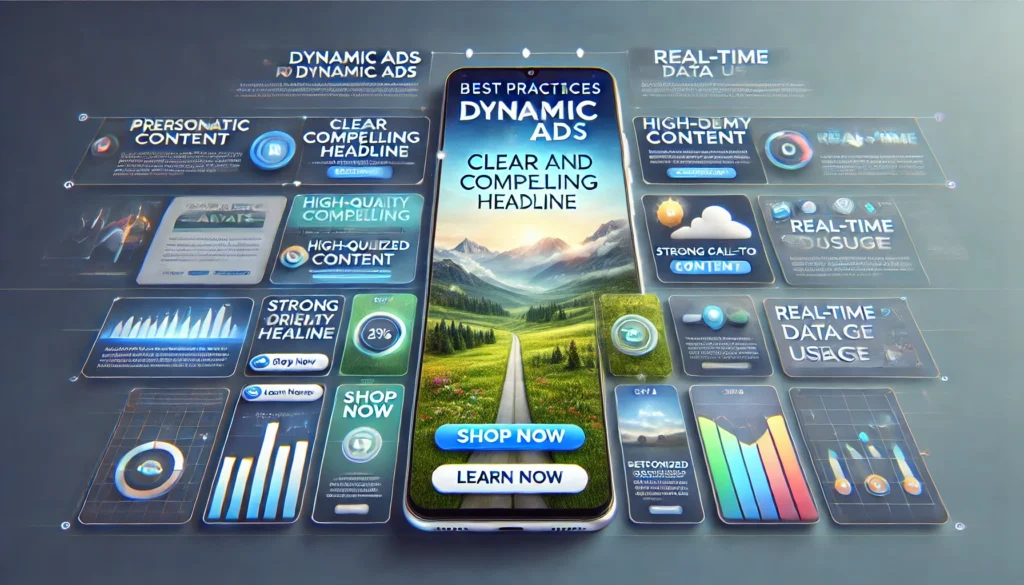In the ever-evolving world of digital marketing, dynamic ads have become a powerful tool for publishers looking to optimize their media buying strategies. These ads, known for their ability to adapt content to suit different audience segments, offer unparalleled flexibility and relevance, driving better engagement and conversion rates. This article delves into how affiliates can harness dynamic ads to generate their own income independently, without the need to partner with other affiliates.

Understanding Dynamic Ads
Dynamic ads have revolutionized the digital advertising landscape by offering personalized content tailored to individual users. In this section, we will explore what dynamic ads are, how they work, and why they are essential for affiliates looking to optimize their media buying strategies.
What Are Dynamic Ads?
Dynamic ads are advertisements that automatically change their content based on user data and behavior. Unlike static ads that deliver the same message to every viewer, dynamic ads customize their content to match the specific interests, demographics, and behaviors of each user. This personalization increases the likelihood of capturing the user’s attention and encouraging interaction.
The Power of Personalization
The key advantage of dynamic ads lies in their ability to provide a personalized experience. For instance, if a user has recently browsed for running shoes, a dynamic ads example would display running shoes in their subsequent ads, along with related products such as athletic wear or accessories. This targeted approach not only enhances user engagement but also boosts conversion rates by presenting relevant products.
Dynamic Ads for Broad Audiences
Reaching a wide array of potential customers is crucial for maximizing revenue. This section delves into the benefits of dynamic ads for broad audiences, illustrating how these ads can effectively engage diverse user segments and drive conversions through targeted messaging.
Reaching a Wider Audience
One of the significant benefits of dynamic ads for broad audiences is their capability to reach diverse user groups with tailored messages. By leveraging data from various sources such as browsing history, location, and past purchases, dynamic ads can cater to a wide range of potential customers. This broad reach is particularly beneficial for affiliates aiming to maximize their income through extensive audience engagement.
Case Study: Dynamic Ads in Action
Consider a dynamic ads example in the e-commerce sector. An online retailer utilizes dynamic ads to promote its products. When a user visits the retailer’s website and looks at a specific product category, such as electronics, the dynamic ads will subsequently display similar or complementary products. This not only keeps the user engaged but also encourages them to complete their purchase, thus driving revenue for the publisher.
Implementing Dynamic Ads
Setting up dynamic ads involves a series of strategic steps, from selecting the right platform to designing adaptable ad templates. In this section, we will guide you through the process of implementing dynamic ads, ensuring you leverage their full potential to enhance your advertising efforts.
Setting Up Dynamic Ads
For affiliates interested in implementing dynamic ads, the process begins with selecting the right advertising platform. Many popular platforms like Google Ads and Facebook Ads offer robust dynamic ads capabilities. Setting up these ads involves creating a product catalog, defining audience segments, and designing ad templates that can dynamically pull in product information.
Optimizing Ad Content
Optimization is crucial for the success of dynamic ads. Affiliates should regularly analyze ad performance data to identify trends and areas for improvement. This might include A/B testing different ad creatives, adjusting targeting parameters, and refining the product catalog to ensure that the most relevant products are being showcased.

Best Practices for Dynamic Ads
To achieve the best results with dynamic ads, it’s important to follow certain best practices. This section will provide insights into tailoring ads to user intent, leveraging dynamic creative optimization, and other key strategies that can significantly boost the performance of your campaigns.
Tailoring Ads to User Intent
Understanding user intent is vital for crafting effective dynamic ads. By analyzing search queries, purchase history, and other behavioral data, affiliates can create ads that directly address the user’s needs and interests. For example, a user searching for “best winter jackets” would be more likely to engage with a dynamic ads example showcasing various winter jacket options, complete with pricing and availability.
Leveraging Dynamic Creative Optimization
Dynamic creative optimization (DCO) is a technique that automates the creation and delivery of personalized ad content. By using machine learning algorithms, DCO can continuously test and optimize different ad elements such as images, headlines, and call-to-actions. This ensures that each user is served the most effective ad variation, maximizing the chances of conversion.
Measuring Success
Tracking the performance of your dynamic ads is vital for continuous improvement. Here, we will discuss the key performance indicators (KPIs) you should monitor, and how to use these metrics to refine your advertising strategies for better results.
Key Performance Indicators
To measure the success of dynamic ads, affiliates should track key performance indicators (KPIs) such as click-through rates (CTR), conversion rates, and return on ad spend (ROAS). These metrics provide insights into how well the ads are performing and where adjustments may be needed.
Continuous Improvement
The dynamic nature of dynamic ads means there is always room for improvement. Affiliates should adopt a mindset of continuous testing and refinement, using performance data to guide their strategies. This iterative approach helps in maintaining high levels of engagement and conversion over time.
Challenges and Solutions
While dynamic ads offer numerous advantages, they also come with their own set of challenges. This section identifies common obstacles affiliates might face when using dynamic ads and provides practical solutions to overcome these issues effectively.
Common Challenges
Despite their benefits, dynamic ads can present certain challenges. These may include technical complexities in setting up ad templates, ensuring data accuracy, and maintaining privacy compliance. Affiliates may also face difficulties in integrating dynamic ads with existing marketing strategies and tools.
Overcoming Obstacles
To overcome these challenges, affiliates should invest in robust ad management platforms and seek support from technical experts if needed. Regular audits of ad performance and data accuracy can help in identifying and resolving issues promptly. Staying informed about privacy regulations and ensuring compliance is also crucial to maintaining user trust and avoiding legal pitfalls.
Future Trends in Dynamic Ads
The landscape of dynamic ads is continually evolving, with new technologies and platforms emerging. In this final section, we will explore the future trends in dynamic ads, including advances in AI and machine learning, and how these developments will shape the future of digital advertising.
Advances in AI and Machine Learning
The future of dynamic ads is closely tied to advancements in AI and machine learning. These technologies are expected to enhance the precision and efficiency of ad personalization, enabling even more tailored and effective advertising. Affiliates who stay ahead of these trends and adopt new technologies early will likely gain a competitive edge.
Integration with Emerging Platforms
As new digital platforms emerge, the scope of dynamic ads will continue to expand. Affiliates should be prepared to leverage these platforms, whether they be new social media networks, streaming services, or virtual and augmented reality environments. Adapting dynamic ads to these new formats can open up additional revenue streams and engagement opportunities.
Conclusion
In conclusion, dynamic ads represent a significant advancement in digital advertising, offering affiliates the opportunity to generate substantial income through personalized, relevant, and engaging ads. By understanding the principles of dynamic ads, implementing best practices, and continuously optimizing their strategies, affiliates can maximize their media buying performance and achieve long-term success.Dynamic ads for broad audiences provide the reach and flexibility needed to engage diverse user groups, while specific dynamic ads examples illustrate the practical applications and benefits of this advertising approach. As the digital landscape continues to evolve, staying informed about the latest trends and technologies will be crucial for affiliates looking to capitalize on the power of dynamic ads.
